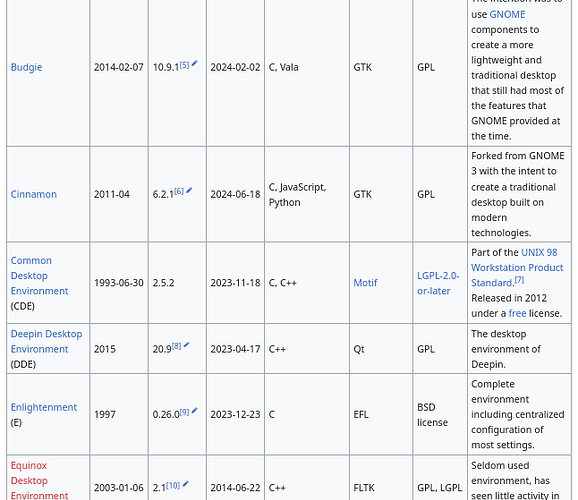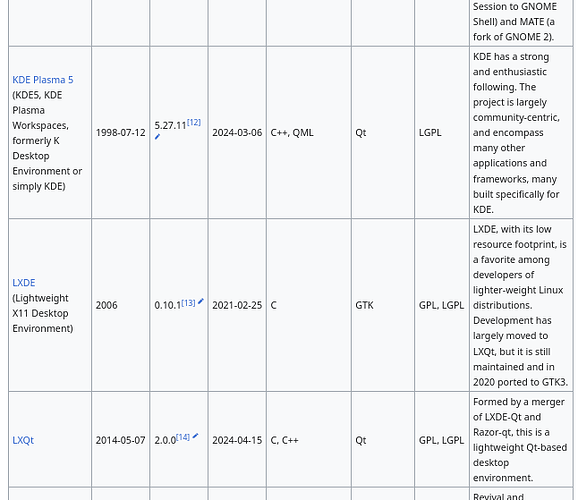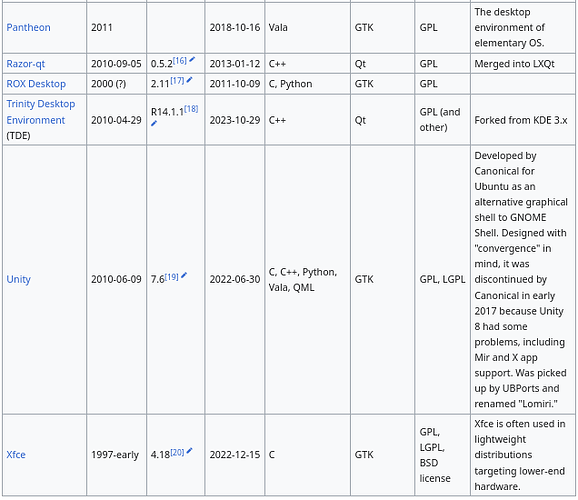Yes, Paul, copies, not backups. I like to choose what is duplicated and not just trust the choices of a backup program.
Hi Paul and Bill,
My backups are always copies of copies of copies. Lately I haven’t had the time or patience, I also make backups with clonezilla and Timeshift
Jorge
I started with Mandrake and was most comfortable with KDE. It seemed most Windows like at the time for me. Years later I used Mint quite a bit with Cinnamon. Still many years later I’m running either Pop!_OS or Ubuntu with Gnome. I guess my taste drifts a bit.
I figured the Firefox time difference might be due to having less memory available due to DE memory use.
Use a VM to try different distros. Safer, although slower, than installing to hardware. Unless you have a spare for distro hopping.
This recent video from Explaining Computers.com offers an excellent explanation about the various Ubuntu derivatives available and where they are placed in the marketplace and for whom.
As for younger Linux users specifically, Edubuntu is designed to be an introduction to Linux at an early age - not unlike the experiences of the past with the BBC Micro.
Hi, Jorge,
To be honest, I have not taken the time to play with them and figure out how they differ. My first Linux was Kubuntu and coming straight from years of Windows (starting at 3.1) and DOS, I thought the KDE was such a refreshing change and stayed with it for some time.
Then I decided to try LM and did not even know what a DE was, so used the default. Again, I saw the differences between KDE & Cinnamon, but not enough to make a difference at first.
Now that I have expanded my Linux options, I would have to say I do not like Gnome, I never cared for the looks of Ubuntu when seeing screenshots on forums, and after finding MX Linux with XFCE, I find it fits me just fine.
As others have pointed out, I don’t want to have to search for things. Right clicking should give me all the options I need in a window and even on the desktop. If I have to go install extensions (in a browser?) to get an desktop app to work, it is frustrating. I’d rather open up a terminal and install what I need or use the pkg mgr. But I am NOT a young Linux user.
When I switched my Mom from Windows to LM, she took a bit to learn how to do things, but that’s because like most Windows users, she expects to point & click and it’s done. Not understanding anything about how computers work, in general, if anything changes, she struggles. But I would say it was the best choice to get her in a new OS…and it was with Cinnamon, since that’s the only one I had used. When LM updated & would not boot to login screen, I had to switch her to Kubuntu as I had pre-installed it as a dual boot system. She instantly saw differences and did not know how to do things.
Other than the visual appeal, I do not think I have enough understanding of how each and every DE differs. I have used Debian 12 and it was not hard to find what I wanted, but I used the Xfce DE. Maybe someone could hit the highlights of the different DEs and how they differ, cause I surely do not know since I keep using what I like.
I know that wasn’t helpful in answering your question, but it is a different perspective.
Thanks,
Sheila
That applies to us all, but we eventually learn how to find one’s way around
something that is new.
I am not sure how you teach someone to ‘find their way’ other than lots of practice.
Some DE’s are better at helping you ‘find your way’ than others… eg prompts when you hover the mouse over an icon or button.
I think that is the best way: we learn by doing. But I think you do have to have some grasp on the concept of computing, etc., or it is simply memorization of the steps taken to produce results.
For instance, we have learned to use smart phones and their tiny desktop layout with app icons, but we understand what an app is. I am having to try and teach my mom how to use her “smart” tv and at first, the frustration was so evident. She swore she would never learn how to get where she wanted to go. She keeps telling me which Channel# she always watched, not the name of the station…LOL. And I have to teach her that the app is the name of the station. She cannot tell the difference when viewing a live channel and an app where she has to choose what to watch. I finally typed up a 2 pg sheet of instructions and she is getting better. But, again, she only knows how do what the instructions say, she does not understand why. Eventually, she will not need the sheet, she will have memorized the steps. But she will never understand the “why” behind choosing one app over another. The same is true of her computer skills.
But we all know the effort it takes to learn something new, different. For me, the reward is not only the end result, but the joy in the journey–the journey of learning something new or a new way to do something old. For others, the frustration outweighs the reward.
Sheila
That sums it up in one sentence.
So how do we teach concepts? That is difficult.
I remember math classes. Learning arithmetic could be done by memorizing rules.
Learning algebra was different… you had to grasp some abstract ideas like symbols to represent variable quantities.
Learning calculus was even harder… rates of change are a more abstract idea than
fixed variables.
Computing does have some abstract concepts…the idea of a program that is stored and can be executed… the idea of a file that is like a paper file but different.
You are right, if you dont grasp things, it is like doing algebra by memory… close to impossible.
Going to be controversial here and say it really does not matter which of these verions or flavours of mint you choose…
They are virtually all the same thing, ok slight colouration differences.
Slight locasion differences
Slight demands on your system resources but well within the same areas disk size memory etc
Even the menus feel the same
Control panel same
New software repositories same
I regularly swap between mate (my prefered) cinnamon and lmde without thought, I even switch between english, french, spanish, german and dutch language versions of each… mainly as I have clients on all these languages in the different flavours without issues or thought. Mainly because I know I can click the menu button, bottom right, go to office and select writer, or menu, internet, firefox.
Same with control panel all the icons look and feel the same.
Only thing that catches me out is position in control panel due to language alphabetical order, so imprimer is in different order to printers … moments hesitation.
Cinnamon is the most popular download from linux mint site add on to that lmde is cinnamon interface that would make it the most commonly used. It used to be older boxes prefered mate. But now that line is vastly reduced.
When you use Linux in a non-English language, are the CLI commands the same or
do they translate them?
All are in english, as linux was written in english , thankfully. Same for windows as original dos or cpm in english.
But that is true of mint, debian, ubuntu etc no idea for Chinese russian or similar language systems no experience on that. I impressed a Moroccan client one day dropping to cli to fix his problem but looking for letters on the keyboard when they were all characters was not as easy, had normal keyboard along side just to check except french english swap q and a plus m and , plus occasionally z and y. Also lucky there are no accents in linux cli. Eéèëėē drives me mad !
They are the same.
sudo, ls, mkdir, rm, mv, etc… those are the same.
On the other hand the messages (error messages) are mostly translated according to system locale (/etc/default/locale ).
Names of directories (XDG_USER_DIRS) in the home folder of users are translated, such as Desktop, Documents, Pictures, etc…
According to ~/.config/user-dirs.locale and ~/.config/user-dirs.dirs
In my attempt to better understand the DEs being discussed, I read on an EndeavorOS forum about someone being confused at all of these DEs, WMs, etc. One participant’s answer seemed to break it down for me here.
That expose then lead me to a Wikipedia article that went even deeper here.
I was surprised to find many of the terms I find so often here on ItsFOSS but never understood (i.e., GTK, QT) and DEs I had never heard of before. Sorry for the snapshot size differences (I am not a graphics-savvy editor):
But perhaps this statement is closest to my understanding of DEs and is why when I install a new Linux OS, I choose the default DE and learn to use it “as is.” Only if I have issues with certain apps incompatibility or not being able to make things work the way I want will I look at other DEs or distros.
Some of the differences which can influence the choice of desktop environment are:
- Look and feel of the desktop environment. The user will be more comfortable with a certain look and feel that they may or may not already be familiar with.
- Flexibility and configurability of the desktop environment. A sophisticated user might want a highly configurable desktop environment to make the desktop environment work the way they want. A beginner might just want an easy-to-use environment to which they will adjust.
- Personal preferences for choice of software, which has two aspects:
- Each desktop environment comes packaged with various default software and various “ways things are done” under that desktop. A casual user might like a highly integrated graphical interface to change various settings while a more experienced user might prefer to use individual configuration utilities or even CL tools.
- Desktops are also often closely tied into various major functional components of the desktop manager (example: file manager, browser, word processor); whilst “mix and match” is possible, it is generally pleasing to make choices which result in a consistent look and feel of programs under the chosen desktop environment. Making choices based on what software integrates with a chosen desktop environment necessarily limits the weight that can be given to other application features.
Look & feel is what I pay attention to in a DE. While flexibility/configurability is important, as noted above, beginners just want something that falls in line with what they already know and, thus, be easy to use.
As for software, I had never considered included apps a hindrance as you can get most apps desired from the source and install them on any DE.
Thanks,
Sheila
Hi, my friends,
Thank you very much for your replies.
I’m going to use one of Paul’s answers to ask another question:
Don’t take my question the wrong way, but it’s this specific issue that I’d like to know the answer to. In your case, why is MATE your favorite (apart from the features) since there are “practically no differences” between MATE and Cinammon?
Thanks
Jorge
Hi, Jorge
I think one person said it best this way:
“Think of it as the dashboard and controls in a car.
They all have pretty much them same gauges, buttons, and switches–but they are located differently–that does not mean you can’t drive the car.
Same with the desktops–you can drive them all. Which do you prefer?”
Cinnamon is weightier than Mate or Xfce. Of course, if you have a modern pc with plenty of RAM, that might not be noticeable. I certainly do not notice it.
LMDE is a Linux Mint distro that is pure Debian base platform vs the other three which are based on Canonicals, (Ubuntu), platform.
Sheila
My dear friends,
Thank you all for your replies
My initial question was this:
How do I choose between the Linux Mint MATE, Cinnamon, Xfce or Debian editions?
Once again, thank you all very much and not wishing to single anyone out, I’ll try to condense the answers that, in my opinion, relate directly to my question:
I think these two excerpts sum up the answer to my question.
Most users agree that Linux Mint is the most suitable distro for Linux beginners, but what I can really “read” and after reading all your posts, which I really appreciate, is “Try all the editions and see which DE you like best” and there’s no way of advising, other than a lack of hardware resources - it’s a question of taste and adaptation, because although they are similar, there are differences between the DE’s, for example, Xfce is totally different from Cinnamon.
As I can’t mark all the answers as “solution”, and forgive all those who have posted, I’ll choose the answer that is in line with what I really think about this subject.
When I started using Linux again, I was advised to use Linux Mint, but I had to test all editions to find out which edition I wanted and the following answer, for me, sums up everything I went through when I had to choose the Linux Mint edition:
(I couldn’t find who said it. My apologies to the author)
Thank you all very much for participating
Regards,
Jorge
As jorge asked I choose mate originally because it worked on older hardware without too many demands, everything was in the box ready, Now lmde is the only current 32 bit mint and still have users on soon to be 20 year old boxes they want to keep using due to costs and the idea of not throwing it away.
Can someone please explain why Mint is so popular.?
Ignoring the DE’s, what does Mint distro do that is so appealing.?
HI Neville,
I share the same opinion as Howard and Paul:
I think it’s a very friendly transition distro from Windows to Linux.
As I’ve already mentioned in previous posts, I had my first contact with Linux through Red Hat in the late 1990s. In the early 2000s I tried Linux again, but this time Mandrake and then 4 years of Debian, between 2006 and 2010. I went back to Windows and, I think, in 2018 I went back to Linux for good and, at that time, I heard a lot about Linux Mint, everyone recommended Linux Mint, I tried Linux Mint and, since then, Linux Mint has been my day-to-day distro. I started with MATE, but I had a lot of problems, because I like to configure the desktop and every now, and then I’d get some errors, so I switched to Cinnamon and that’s what I still use.
For those who like to work with desktop environments, in my opinion, Linux Mint Cinnamon is a very pleasant choice.
On my laptop, I think differently: I use Manjaro KDE and, so far at least, I wouldn’t change it for another distro. Because it’s a totally different architecture, and it works perfectly on my desktop. It’s ridiculous what I’m about to say, but I’ve already installed Linux Mint Cinnamon on my laptop and I prefer Manjaro.
As for working with audio, there is a totally different distro: I work with Debian Testing configured by me and with Xfce, all because my PC is very old, to have the lowest possible latency one of the commercial programs I use, the distribution is Debian (packages).
I used MX Linux Xfce for a while, but I preferred Debian Testing.
In the end, it’s all a question of taste.
Jorge
Hi, Neville
I think @abhishek summed it all up in one of his articles here.
Key takeaways:
- Gnome vs Cinnamon, hands down Cinnamon is lighter and LM is, therefore, snappier.
- Software sources available that are not in others and pre-installed software beats the ones in other distros.
- For beginners and especially those coming from Windows, they seem to have applied a certain “logic” of how to do things, get around, that those beginners and former Windows users can adapt to pretty quickly.
But he also agreed that he gets bored with LM after using it a while. And I am inclined to agree. It was only my 2nd Linux distro and I spent a lot of time setting it up to make it work for my business as well as personal stuff.
But as you “grow into” Linux and gain command of the terminal and begin looking at all the other distros and find out how you can set the entire system up your way, “build one” yourself, LM becomes simple.
And “simple” is what a lot of folks want in their computers. Others, like us, want to experiment, “test drive that car” and see what all we can accomplish in starting with simple and ending up with our own masterpiece.
Hope that helps ![]()
Sheila


